
Soraya Esfandiary-Bakhtiary was Queen of the Imperial State of Iran as the second wife of Shah Mohammad Reza Pahlavi, whom she married in 1951. Their marriage suffered many pressures, particularly when it became clear that she was infertile. She rejected the Shah's suggestion that he might take a second wife in order to produce an heir, as he rejected her suggestion that he might abdicate in favor of his half-brother. In March 1958, their divorce was announced. After a brief career as an actress, and a liaison with Italian film director Franco Indovina, Soraya lived alone in Paris until her death.
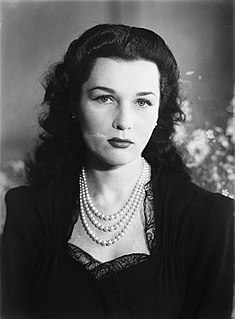
Fawzia of Egypt, also known as Fawzia Chirine, was an Egyptian princess who became Queen of Iran as the first wife of Mohammad Reza Pahlavi, Shah of Iran.
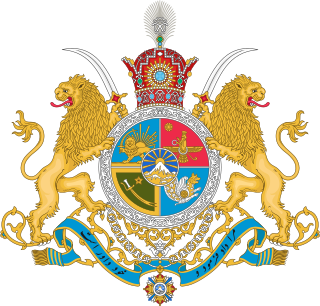
The Pahlavi dynasty was the last Iranian royal dynasty, ruling for almost 54 years between 1925 and 1979. The dynasty was founded by Reza Shah Pahlavi, a non-aristocratic Mazanderani soldier in modern times, who took on the name of the Pahlavi language spoken in the pre-Islamic Sasanian Empire in order to strengthen his nationalist credentials.

Shahbanu was the title for empress consort in Persian and other Iranian languages. The two Sassanian empresses regnant, Boran and Azarmidokht, c. 630, were the last two that carried the title before Farah Pahlavi, the wife of Mohammad Reza Pahlavi, the last Shah of Iran (Persia), assumed the title on being crowned queen in 1967 for the first time since the Muslim conquest of Persia in the 7th century.

Reza Pahlavi is the oldest son of Mohammad Reza Pahlavi, the last Shah of Iran, and his wife Farah Diba. Prior to the Iranian Revolution in 1979, he was the crown prince and the last heir apparent to the throne of the Imperial State of Iran.
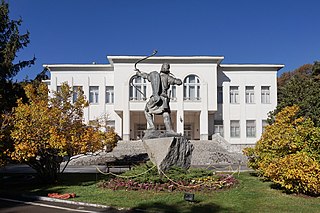
The Sa'dabad Complex is a 110 hectare complex built by the Qajar and Pahlavi monarchs, located in Shemiran, Greater Tehran, Iran. Today, the official residence of the President of Iran is located adjacent to the complex.

Shahnaz Pahlavi is the first child of the Shah of Iran, Mohammad Reza Pahlavi, and his first wife, Princess Fawzia of Egypt.

Ashraf ol-Molouk Pahlavi was the twin sister of Mohammad Reza Pahlavi, the last Shah of Iran (Persia), and a member of the Pahlavi dynasty. She was considered the "power behind her brother" and was instrumental in the 1953 coup that overthrew Prime Minister Mohammad Mosaddegh in favour of strengthening the monarchical rule of the Shah. She served her brother as a palace adviser and was a strong advocate for women's rights. Following the Iranian Revolution in 1979, she lived in exile in France, New York, Paris and Monte Carlo and remained outspoken against the Iranian Islamic Republic.
An Enduring Love: My Life with the Shah is a book written in 2004 by Farah Pahlavi, the former Shahbanu (Empress) of Iran, who has been living in exile since the Iranian Revolution in 1979 which saw overthrow of the Pahlavi Dynasty. It is a memoir about Farah, her life before she met the Shah and how she married him and became the Queen and later Empress of Iran. The book is also about her husband, Mohammad Reza Shah Pahlavi, his personality, his family and how he reigned over the country of Iran for 37 years.
Imperial Majesty is a style used by Emperors and Empresses. It distinguishes the status of an emperor/empress from that of a King/Queen, who are simply styled Majesty. Holders of this style have sometimes been observed to follow religious leaders who are styled "His Holiness" in public ceremonies.

Nahid Persson Sarvestani is a Swedish-Iranian documentary filmmaker.
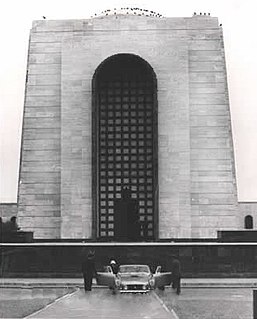
The mausoleum of Reza Shah, located in Ray south of Tehran, was the burial ground of Reza Shah Pahlavi (1878–1944), the penultimate Shahanshah (Emperor) of Iran. It was built close to Shah-Abdol-Azim shrine.
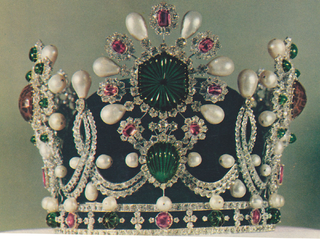
The Empress Crown is part of the coronation regalia used by the only Shahbanu (Empress) of Iran, Farah Pahlavi. It is part of the Iranian Crown Jewels and is currently on display at the Central Bank of Iran in Tehran.
Leila Pahlavi was a princess of Iran and the youngest daughter of Mohammad Reza Pahlavi, Shah of Iran, and his third wife, Farah Pahlavi.
Swedish Iranians or Swedish Persians consist of people of Iranian nationality who have settled in Sweden, as well as Swedish residents and citizens of Iranian heritage. As of 2019, there were 80,136 residents of Sweden born in Iran, as well as 40,883 born in Sweden with at least one Iranian-born parent.
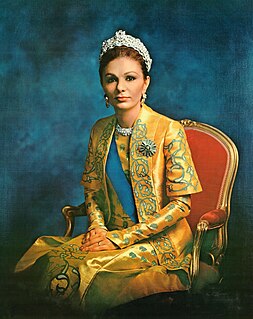
Farah Pahlavi is the widow of the last Shah of Iran, Mohammad Reza Pahlavi, and was successively Queen and Empress (Shahbanu) of Iran from 1959 to 1979. She was born into a prosperous family whose fortunes were diminished after her father's early death. While studying architecture in Paris, France, she was introduced to the Shah at the Iranian embassy, and they were married in December 1959. The Shah's first two marriages had not produced a son—necessary for royal succession—resulting in great rejoicing at the birth of Crown Prince Reza in October of the following year. Diba was then free to pursue interests other than domestic duties, though she was not allowed a political role. She worked for many charities, and founded Iran's first American-style university, enabling more women to become students in the country. She also facilitated the buying-back of Iranian antiquities from museums abroad.

Layla Soudavar Diba is an Iranian-American independent scholar and curator, specializing in 18th/19th-century and contemporary Persian art and the Qajar period. She has curated various exhibitions, such as the Royal Persian Paintings: The Qajar Epoch 1783-1925 (1998-1999) exhibition at the Brooklyn Museum and co-curated Iran Modern (2013) at New York’s Asia Society.

Farideh Ghotbi, also known as Farideh Diba, was an Iranian public figure. She was the mother of Farah Pahlavi, the former Shahbanu and third wife of Mohammad Reza Pahlavi, the last Shah of Iran. Ghotbi was known for her influence on both her daughter and within the Diba and Pahlavi families.














